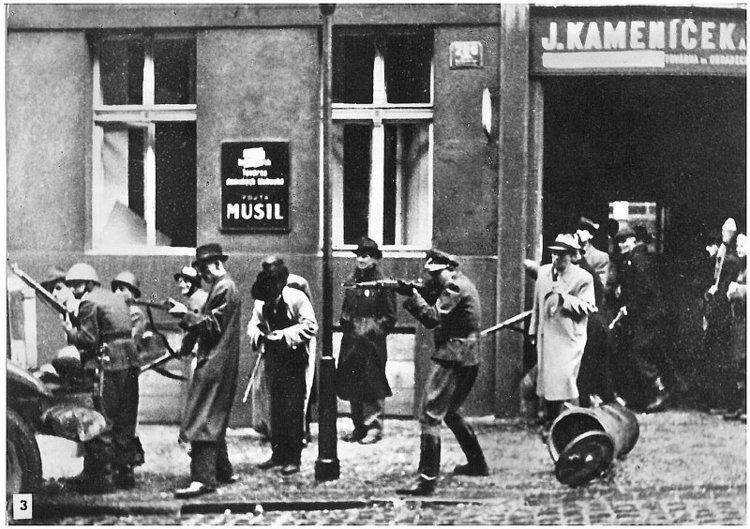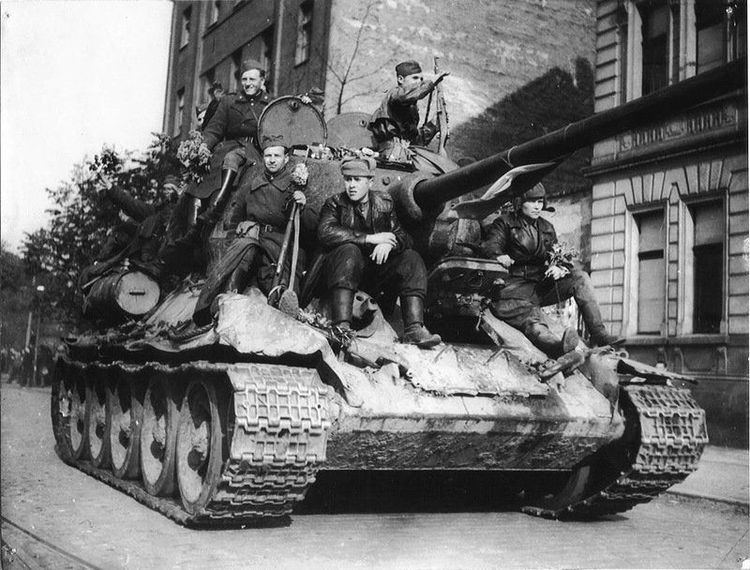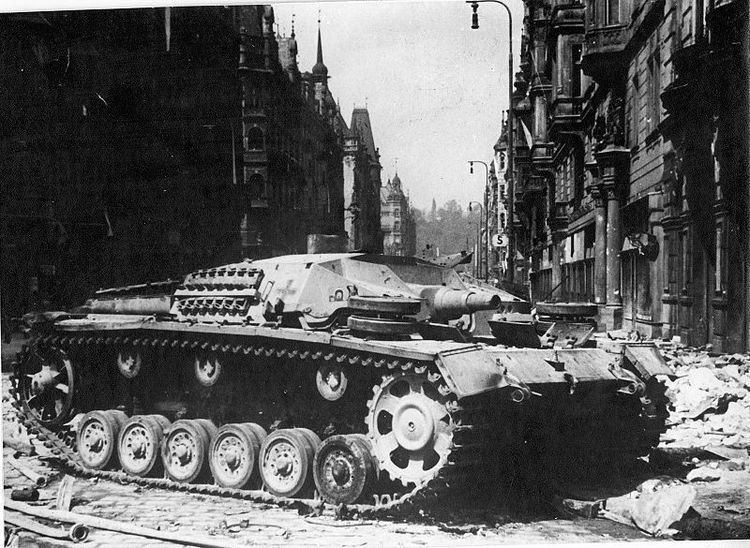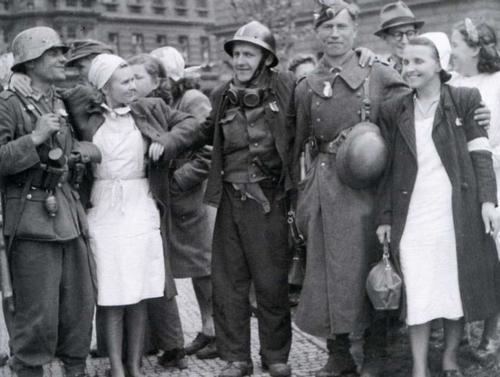Dates 5 May 1945 – 8 May 1945 | ||
 | ||
Similar World War II, Prague Offensive, Operation Anthropoid, Slovak National Uprising, Battle of the Dukla Pass | ||
Last wwii european battlefield bohemia may 1945 prague uprising
The Prague uprising (Czech: Pražské povstání) was an attempt by the Czech resistance to liberate the city of Prague from German occupation during World War II. Events began on May 5, 1945, in the last moments of the war in Europe. The uprising went on until May 8, 1945, ending in a ceasefire between the Czech resistance and the German army, which decided to quit Prague on the same day. Next morning, the Red Army entered the nearly liberated city.
Contents
- Last wwii european battlefield bohemia may 1945 prague uprising
- Prior to Uprising
- Battle for Czech Radio
- Uprising
- German counter attack
- The SS attack
- The ROA defection
- German retreat
- Liberation
- Czechs
- Germans
- Others
- Casualties
- References

Prior to Uprising

Several factors greatly influenced the daily life of the majority of people, including the militarization of the economy, the elimination of political rights, transportation to Germany for forced labor, and national oppression. Various forms of German oppression in the cities affected not only the working class, but also the "middle strata"—the small and middle businessmen, and the lower categories of state and civic employees, for example.

The most important task of the Czechs was to stop the Germans from disturbing what Czechoslovak territory they still occupied as well as to stop them from continuing the war on Czech soil. The goal of the resistance was to force the German occupants to retreat to Germany. The Czech Resistance needed the support and help of the Red Army in order to become fully liberated.

As the end of the war came closer, it had a powerful effect on the residents all over Czechoslovakia. In fact, it strengthened their longing to explicitly demonstrate their bitter hatred toward the German occupants. During the German occupation of Czechoslovakia, tensions had built up because of oppression. This would later lead to the expulsion of three million Sudeten Germans from their homes of 800 years.

In the spring of 1945 throughout Czechoslovakia, there were both many large and small partisan groups that totaled about 7,500 people. These followers mostly took part in the "battle of the rails", in which they disturbed the railway and highway transportation, attacked trains and stations, as well as German troop trains, and damaged tracks and bridges. For example, there were some lines the Germans could use only in the daytime and not even every day.

On the eve of the uprising, the propaganda activities of the group called the Communist Youth, were in full swing, but didn’t last long. The communist groups whose solidarity had been broken by arrests in March were somehow able to work under the tough circumstances of illegality.
Battle for Czech Radio
From 30 April-1 May 1945, the Waffen-SS Senior Group Leader (Obergruppenführer) and General of Police Karl Hermann Frank announced over the radio in Prague that he would drown any uprising in a "sea of blood". As rumors of an impending Allied approach reached Prague, the people of Prague streamed into the streets to welcome the victors. Frank ordered the streets to be cleared and instructed the German army and police forces in Prague to fire at anyone who disobeyed.
On 5 May, the uprising was triggered in the morning by a broadcast on Czech radio. In a mixture of Czech and German, the broadcast announced: "It is just six o' clock". A group of Czech policemen attempted to seize the radio building on Vinohradská street, without realizing that a detachment of SS soldiers was already stationed there, which resulted in bitter fighting. With the sounds of combat in the background, the radio station continued to broadcast messages of defiance, encouraging citizens to revolt. The Prague radio broadcast an appeal to all Czechs to come to the radio building's defence: it was the beginning of five days of fierce fighting in Prague:
"Calling all Czechs! Come to our aid immediately! Calling all Czechs!"
The radio was during this time (5 May-25 May 1945) led by Otakar Matousek, a former director of scientific programmes at the radio before the war [5,6].
Uprising
At about 1:00 pm on May 5, 1945, armed Czech resistance fighters overwhelmed the Waffen-SS defending the radio buildings. The radio announcer broadcast a call to the Czech nation to rise up and asked the people in the streets of Prague to build barricades. Elsewhere, Czech resistance fighters occupied the Gestapo and Sipo Headquarters.
In the afternoon of May 5, the Prague mayor formally switched allegiance to the National Committee in the City Hall. The Czechs in the streets tore down the German road traffic signs and store inscriptions. The insurgents attacked any Germans within sight and seized their weapons. The Germans defended themselves as best as they could by shooting at the insurgents.
In the remaining hours of May 5, the insurgents' camp learned of the Nazis' intent to eliminate the uprising by using a very heavily armed attack from the outside. The intent of this maneuver was to join up with the local German forces that were positioned inside the city. The news reached Prague Resistance Headquarters of German tanks, armored carriers, weaponry and motorized units that were heading for the capital city. However, in the evening hours of May 5, the balance of power between the insurgents and the Germans started to change. After a phase of dominance of the insurgents in the beginning of the uprising, a phase of stabilization began, which was also an equalization of power.
By the morning of May 6, over 1,000 barricades were erected. Czech resistance troops had managed to seize half of the city before the Germans reacted in force. German garrisons throughout Prague were surrounded. The insurgents forced the besieged Germans to surrender by cutting off their electricity, water supplies, and telephone wires. Prague experienced a rash of anti-German excesses, while some Germans, mainly the SS, took revenge on the Czech non-combatants.
German counter-attack
German forces outside of Prague started to move toward the city center in order to relieve their trapped countrymen. The other objective of these German forces was the capture of the railroad and highway communication network. Possession of these vital transportation links would secure free passage westward to the American lines for the Wehrmacht Heer troops of Army Group Center.
On May 6, the Germans attempted to recapture the radio station building. As the German advance ran into significant resistance, both in the building itself and at the barricades in nearby streets, the Germans decided to use bombers instead. This attack was a success. However, the Czech resistance managed to continue to broadcast its message from the Hussite church tower. The tower was used on the 7–9 May 1945 as an impromptu radio tower when it also sheltered Czech resistance fighters who were trying to evict the occupying German force from the city.
With news that Americans were already in Pilsen, hopes were initially high about their tanks reaching Prague soon. But the insurgents were not aware of the demarcation line agreement between the Americans and the Soviets some 70 km (43 mi) west of Prague. The Czech radio appeals to the United States Army remained unanswered. Insurgents also did not know where the Red Army might be at the time and the German military pressure was increasing.
The SS attack
On May 7, Waffen-SS armoured and artillery units stationed outside of Prague, frustrated by the lack of decisive progress made by the Heer infantry, launched several furious tank attacks on the city defenders. The situation was grave. The Waffen-SS started to use their heavy equipment and even the feared Luftwaffe air raids were launched on Prague. Many downtown historical landmarks were bombed. In the next hours, the German occupation forces gradually overwhelmed the Czech fighters. The resistance had only a few anti-tank weapons to counter German tanks. In addition, their ammunition was running out.
The ROA defection
During the march south, the 1st Infantry Division (600th German Infantry Division) of the Russian Liberation Army (ROA) commanded by General Sergei Bunyachenko came to the help of the Czech insurgents to support the Prague uprising which started on May 5, 1945, against the German occupation. The ROA was created by former Soviet General Andrey Vlasov as an anti-communist Russian force in the combat against Bolshevism. Vlasov was initially reluctant, but ultimately did not resist General Bunyachenko's decision to fight against the Germans. The first division engaged in battle with Waffen-SS units that had been sent to level the city. The ROA units armed with heavy weaponry fended off the relentless SS assault, and together with the Czech insurgents succeeded in preserving most of Prague from destruction. Due to the predominance of Communists in the new Czech Rada, the first division had to leave the city the very next day and tried to surrender to the US Third Army of General Patton. The Allies, however, had little interest in aiding or sheltering the ROA, fearing such aid would severely harm relations with the Soviet Union. Soon after the failed attempt to surrender to the Americans, Bunyachenko, Vlasov, and the ROA forces in general were returned to the Soviet Union, after which they were mostly executed as traitors.
German retreat
On May 8, faced with no arriving allied help and the imminent destruction of the city, the insurgents were forced to negotiate, and accepted the German terms presented by General Rudolf Toussaint, the German Military Governor. Formally called the German capitulation, in fact it gave the German forces and civilians the opportunity to not follow the terms of surrender and escape to the west, to American captivity. In return, Prague would not be destroyed in fights. The insurgent leaders were already informed that American Army would not move from its final positions, while on the other hand the Red Army seemed to be days away from Prague. So the compromise seemed to be the only hope, though it fulfilled most of the German demands. In fact, the capitulation saved only the German forces in Prague and vicinity; most of the German units on the Eastern front couldn't benefit from the free passage through Prague, because of the rapid advance of Soviet units from the north which arrived to Prague in the morning of May 9.
Liberation
On May 9, the Soviet Red Army entered Prague. U.S. Army units had been closer to Prague than Soviets, and their reconnaissance units were already present in the suburbs of Prague when the uprising culminated. However, the Americans did not help the Czech insurgents due to previous political agreements with the Soviets.
Czechs
Germans
Others
Casualties
Since the most organized basis for an uprising is to have it led by an armed struggle, there will usually be many casualties. During the uprising in Prague 1,694 Czechs were killed and another 1,600 seriously wounded. Almost 1,000 German Soldiers were killed. The number of German civilian casualties is unknown. The Vlasov Army lost 300 men. On May 9, the Red Army casualties amounted to 30 killed. However, many other victims were never identified.
